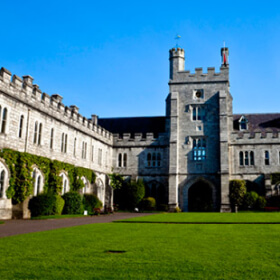Researchers' Blog
Meet the Crops, Perennial Ryegrass and White Clover in the Spotlight

An insight into why these plants are important to our project (and the whole of Ireland).
Written by Grace Hurley (PhD Student)
Perennial Ryegrass (Lolium perenne) and White Clover (Trifolium repens) are crops of great significance for the Irish dairy sector. These crops are commonly known as forage crops which means they play an important role for grazing systems.
Perennial Ryegrass is a high yielding forage crop which is valued for its quick establishment, easy digestibility and palatability for grazing animals, its high productivity, and its ability to endure repeated grazing or cutting. Previous research has shown that perennial ryegrass responds well to the application of nitrogen-based fertilizers. However, this can have both environmental and economic impacts, raising the need to develop new and sustainable ways of providing nitrogen to this crop. This can be achieved by incorporating legumes into perennial ryegrass swards.
White clover is a legume plant that can host symbiotic bacteria capable of fixing atmospheric nitrogen (N²) into ammonium (NH⁴), a form which plants can absorb and utilise. Therefore, the establishment of multispecies swards combining white clover and perennial ryegrass provides multiple benefits. These include the improved quality and yield of the perennial ryegrass, the improved performance of grazing animals, an extended length of the grazing season, the reduction in the use of nitrogen-based fertilizers, and an increased nitrogen absorption by the grass.
Perennial ryegrass has been extensively commercially bred as a forage crop. Although these varieties are optimal for current agricultural practices when compared to ecotypes (genetically diverse and naturally selected by the environment), they are more vulnerable to future climate conditions.
With the increase in frequency of extreme weather events (e.g., flooding, drought, high temperatures), the productivity of Irish forage crops will be affected. Therefore, new varieties of perennial ryegrass and white clover will be needed to cope with future climate conditions. The ResilientCrop project will address this issue by assessing both the physiological and molecular responses of different European ecotypes of perennial ryegrass grown, alone or in combination with white clover, under future climate conditions. This approach will identify specific strategies and regulators which can provide resilience to climate change in these forage crops.
References;
- Andrews M, Scholefield D, Abberton MT, McKenzie BA, Hodge S, Raven JA. 2007. Use of white clover as an alternative to nitrogen fertiliser for dairy pastures in nitrate vulnerable zones in the UK: Productivity, environmental impact, and economic considerations. Annals of Applied Biology 151: 11–23.
- Li, Z., Peng, Y. and Ma, X., 2013. Different response on drought tolerance and post-drought recovery between the small-leafed and the large-leafed white clover (Trifolium repens L.) associated with antioxidative enzyme protection and lignin metabolism. Acta physiologiae plantarum, 35(1), pp.213-222.

